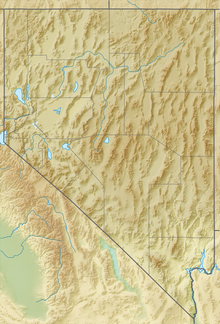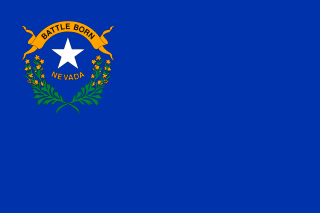
Nevada is a state in the Western region of the United States. It is bordered by Oregon to the northwest, Idaho to the northeast, California to the west, Arizona to the southeast, and Utah to the east. Nevada is the 7th-most extensive, the 19th-least populous, and the 9th-least densely populated of the U.S. states. Nearly three-quarters of Nevada's people live in Clark County, which contains the Las Vegas–Paradise metropolitan area, including three of the state's four largest incorporated cities. Nevada's capital is Carson City.

Nevada City is the county seat of Nevada County, California, United States, located 60 miles (97 km) northeast of Sacramento, 84 miles (135 km) southwest of Reno and 147 miles (237 km) northeast of San Francisco. The population was 3,068 as of the 2010 Census.

Ely is the largest city and county seat of White Pine County, Nevada, United States. Ely was founded as a stagecoach station along the Pony Express and Central Overland Route. In 1906 copper was discovered. Ely's mining boom came later than the other towns along US 50. The railroads connecting the transcontinental railroad to the mines in Austin, Nevada and Eureka, Nevada have long been removed, but the railroad to Ely is preserved as a heritage railway by the Nevada Northern Railway and known as the Ghost Train of Old Ely. As of the 2010 census, the population was 4,255.
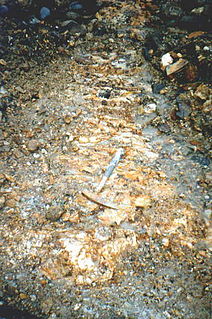
In geology, a lode is a deposit of metalliferous ore that fills or is embedded in a fissure in a rock formation or a vein of ore that is deposited or embedded between layers of rock. The current meaning dates from the 17th century, being an expansion of an earlier sense of a "channel, watercourse" in late Middle English, which in turn is from the 11th-century meaning of lode as a ‘course, way’.

Austin is an unincorporated town in Lander County, Nevada, United States. In 2010, the census-designated place of Austin had a population of 192. It is located on the western slopes of the Toiyabe Range at an elevation of 6,575 feet (2,004 m). U.S. Route 50 passes through the town.

Rhyolite is a ghost town in Nye County, in the U.S. state of Nevada. It is in the Bullfrog Hills, about 120 miles (190 km) northwest of Las Vegas, near the eastern boundary of Death Valley National Park. The town began in early 1905 as one of several mining camps that sprang up after a prospecting discovery in the surrounding hills. During an ensuing gold rush, thousands of gold-seekers, developers, miners and service providers flocked to the Bullfrog Mining District. Many settled in Rhyolite, which lay in a sheltered desert basin near the region's biggest producer, the Montgomery Shoshone Mine.

Cactus Springs is a ghost town in Nye County, Nevada. It is currently within the boundaries of the Nellis Air Force Range.
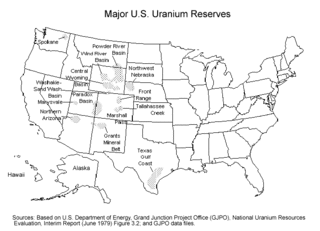
Uranium mining in the United States produced 173,875 pounds (78.9 tonnes) of U3O8 in 2019, 88% lower than the 2018 production of 1,447,945 pounds (656.8 tonnes) of U3O8 and the lowest US annual production since 1948. The 2019 production represents 0.3% of the anticipated uranium fuel requirements of the US's nuclear power reactors for the year.

Silver mining in Nevada, a state of the United States, began in 1858 with the discovery of the Comstock Lode, the first major silver-mining district in the United States. Nevada calls itself the "Silver State." Nevada is the nation's second-largest producer of silver, after Alaska. In 2014 Nevada produced 10.93 million troy ounces of silver, of which 6,74 million ounces were as a byproduct of the mining of gold. The largest byproducers were the Hycroft Mine, the Phoenix Mine, the Midas Mine and Round Mountain.

Mark Eugene Amodei is an American lawyer and politician serving as the U.S. Representative for Nevada's 2nd congressional district since 2011. The only Republican in Nevada's congressional delegation, he served in the Nevada Assembly from 1997 to 1999 and in the Nevada Senate, representing the Capital District, from 1999 to 2011. Amodei chaired the Nevada Republican Party from 2010 until 2011, when he stepped down in order to pursue the nomination for a special election for Congress; he was the Republican nominee in the election held on September 13, 2011, to replace Dean Heller, who had been appointed to the United States Senate. He became the dean of Nevada's congressional delegation once Heller lost his election for a second full term in 2019, although Dina Titus served one term in the House before he was first elected.

Gold mining in Nevada, a state of the United States, is a major industry, and one of the largest sources of gold in the world. In 2018 Nevada produced 5,581,160 troy ounces, representing 78% of US gold and 5.0% of the world's production. Total gold production recorded from Nevada from 1835 to 2017 totals 205,931,000 troy ounces (6,405.2 t), worth US$322.6 billion at 2020 values. Much of Nevada's gold production comes from large open pit mining using heap leaching recovery.

Broken Hills is a ghost town in Mineral County, Nevada. It was primarily the site of the mining operation of miners, Joseph Arthur and James Stratford from 1913 to 1920. The settlement reached the height of popularity during World War I.

The Bodie Mountains are a mountain range primarily in western Mineral County, Nevada.
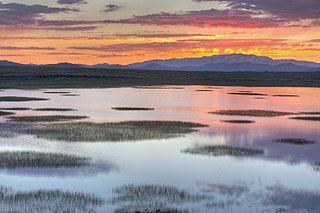
The Bodie Hills are a low mountain range in Mono County, California, in the United States. The Bodie Hills are between Bridgeport and the Nevada border, where they become the Bodie Mountains in Mineral County, Nevada. The Sierra Nevada lies to the west. The mining district and town of Bodie, California, is located in the Bodie Hills.

Hunt's Hill is a former mining camp in Nevada County, California, United States. Hunt's Hill was located in the Sierra Nevada foothills about 6 miles in a straight line southeast of Nevada City and about 2 miles northwest of You Bet, on the north side of Greenhorn Creek, not far from the present intersection of Red Dog and Buckeye Roads. Hunt's Hill was founded in 1852 by a miner named Hunt. It was located on one of the deepest parts of the rich Blue Lead channel of gold-bearing gravel. In 1855, one of the mining claims established by some French miners, was “jumped". During the fight, one of the French miners lost an eye. Thereafter, that mine, and sometimes the town, were called Gouge Eye. By 1857, the town boasted two saloons, a hotel, a blacksmith and stable, a butcher shop, a boot and shoe store, and several grocery stores. In 1858, a stage line from Nevada City arrived. In 1866, seven cement mills for extracting gold from the “blue cement” were operating in the area. By 1880, the town was reduced to a combined store and saloon and a few houses. In 1895, one directory summed up the state of the community thus: "At the present time there is not much doing there." Since that same directory identified the town's justice of the peace and constable, what little happened must have been interesting. Today, it is just a historic site.
The Buena Vista Mine is located 21 miles (34 km) south of Lovelock, Nevada. In the past, the area has been known as the Mineral Basin, though another name for the area has been the Buena Vista District. There are at least two other Buena Vista Mining Districts in Nevada, one is located near Unionville, Nevada, the other located in Esmeralda and Mineral counties near the California border. The nearby Buena Vista Hills are named for the mine. The district encompasses roughly 21 square miles (54 km2) of mineral and surface rights, and is one of the largest un-mined iron ore resources in the western United States.

Hidalgoite, PbAl3(AsO4)(SO4)(OH)4, is a rare member of the beudantite group and is usually classified as part of the alunite family. It was named after the place where it was first discovered, the Zimapán mining district, Hidalgo, Mexico. At Hidalgo where it was initially discovered, it was found as dense white masses in alternating dikes of quartz latite and quartz monzonite alongside other secondary minerals such as sphalerite, arsenopyrite, cerussite and trace amounts of angelsite and alamosite, it was then rediscovered at other locations such as Australia where it occurs on oxidized shear zones above greywacke shales especially on the anticline prospects of the area, and on fine grained quartz-spessartine rocks in Broken Hill, Australia. Hidalgoite specimens are usually associated with copper minerals, clay minerals, iron oxides and polymetallic sulfides in occurrence.

Groom Mine, located in Lincoln County, Nevada, first opened in the 1870s. Most mining in the area, mostly of silver chloride ores, had finished by 1874. Groom Mine continued to operate, finally ceasing operations in 1954. By 1956, official recordings of products of the Groom Mining District, which includes Groom Mine, shows that lead was the bulk of minerals harvested, which also included 145,000 troy ounces (4,500 kg) of silver and about 45 troy ounces (1.4 kg) of gold. During World War II, Groom Mine became surrounded by military activity, which continued into the 21st century. In the 1950s, the mine was exposed to fallout from nuclear testing that was being carried out at the Nevada Test Site. During the late 20th century, military activities, including the destruction of a mill and the restriction of access to the mine, continued to affect work there. The United States Government seized the mine under eminent domain from its previous owners in 2015. Just compensation was set at $1.204 million by the United States District Court, District of Nevada, Judge Miranda Du presiding.

Inesite is a hydrous calcium manganese silicate mineral. Its chemical formula is Ca2Mn7Si10O28(OH)2•5(H2O). Inesite is an inosilicate with a triclinic crystal system. It has a Mohs hardness of 5.5 to 6, and a specific gravity of 3.0. Its name originates from the Greek Ίνες (ines), "fibers" in allusion to its color and habit.

Treasure City is an abandoned mining town located in the Treasure Hill region of the White Pine Range, in western White Pine County, Nevada, United States.
